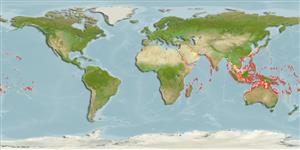Environment: milieu / climate zone / profondeur / distribution range
Écologie
marin récifal; profondeur 0 - 45 m (Ref. 58652). Tropical; 35°N - 30°S, 30°E - 140°W
Indo-Pacific: Red Sea and East Africa to the Hawaiian, Line and Tuamoto islands, north to southern Japan, south to Australia.
Length at first maturity / Taille / Poids / Âge
Maturité: Lm 22.6, range 23 - ? cm
Max length : 53.0 cm FL mâle / non sexé; (Ref. 125599); common length : 45.0 cm TL mâle / non sexé; (Ref. 57863); poids max. publié: 3.6 kg (Ref. 125599)
Épines dorsales (Total) : 11; Rayons mous dorsaux (Total) : 11 - 12; Épines anales: 3; Rayons mous anaux: 11 - 12.
Body shape (shape guide): fusiform / normal; Cross section: compressed.
Found in aggregations over hard, algal coated bottoms of exposed, surf-swept outer reef flats, lagoon and seaward reefs, to a depth of at least 24 m (Ref. 30573). Benthopelagic (Ref. 58302). Juveniles associated with floating material (Ref. 58302). Mainly herbivorous, feeding on seaweed and associated invertebrates (Ref. 30573). Appear to be more commonly involved in hallucinogenic fish poisoning than most other related species (Ref. 4690). Caught with other types of artisanal gear. Minimum depth reported taken from Ref. 128797.
Knudsen, S.W. and K.D. Clements, 2013. Revision of the fish family Kyphosidae (Teleostei: Perciformes). Zootaxa 3751(1):001-101. (Ref. 95491)
Statut dans la liste rouge de l'IUCN (Ref. 130435: Version 2025-1)
Menace pour l'homme
Poisonous to eat (Ref. 4690)
Utilisations par l'homme
Pêcheries: intérêt commercial mineur; pêche sportive: oui
Outils
Articles particuliers
Télécharger en XML
Sources Internet
Estimates based on models
Preferred temperature (Réf.
123201): 24.7 - 29, mean 27.7 °C (based on 854 cells).
Phylogenetic diversity index (Réf.
82804): PD
50 = 0.5000 [Uniqueness, from 0.5 = low to 2.0 = high].
Bayesian length-weight: a=0.01995 (0.01253 - 0.03176), b=3.01 (2.87 - 3.15), in cm total length, based on LWR estimates for this species & (Sub)family-body (Ref.
93245).
Niveau trophique (Réf.
69278): 2.9 ±0.33 se; based on food items.
Generation time: 4.4 ( na - na) years. Estimated as median ln(3)/K based on 1
growth studies.
Résilience (Réf.
120179): Milieu, temps minimum de doublement de population : 1,4 à 4,4 années (K=0.25).
Fishing Vulnerability (Ref.
59153): Moderate vulnerability (38 of 100).
🛈
Climate Vulnerability (Ref.
125649): High vulnerability (62 of 100).
🛈
Nutrients (Ref.
124155): Calcium = 43.6 [27.1, 58.6] mg/100g; Iron = 0.56 [0.38, 0.86] mg/100g; Protein = 19 [18, 20] %; Omega3 = 0.123 [0.091, 0.167] g/100g; Selenium = 34.6 [22.7, 54.6] μg/100g; VitaminA = 63.4 [24.5, 160.6] μg/100g; Zinc = 1.27 [0.97, 1.64] mg/100g (wet weight);
